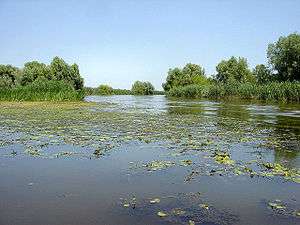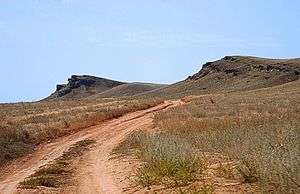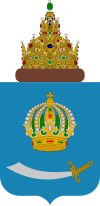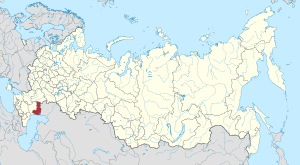Astrakhan Oblast
| Astrakhan Oblast Астраханская область (Russian) | |||||
|---|---|---|---|---|---|
| — Oblast — | |||||
| |||||
| |||||
|
| |||||
| Political status | |||||
| Country | Russia | ||||
| Federal district | Southern[1] | ||||
| Economic region | Volga[2] | ||||
| Established | December 27, 1943[3] | ||||
| Administrative center | Astrakhan | ||||
| Government (as of April 2014) | |||||
| • Governor[4] | Alexander Zhilkin[5] | ||||
| • Legislature | State Duma[6] | ||||
| Statistics | |||||
| Area (as of the 2002 Census)[7] | |||||
| • Total | 44,100 km2 (17,000 sq mi) | ||||
| Area rank | 55th | ||||
| Population (2010 Census)[8] | |||||
| • Total | 1,010,073 | ||||
| • Rank | 52nd | ||||
| • Density[9] | 22.9/km2 (59/sq mi) | ||||
| • Urban | 66.7% | ||||
| • Rural | 33.3% | ||||
| Population (January 2013 est.) | |||||
| • Total | 1,013,800[10] | ||||
| Time zone(s) | SAMT (UTC+04:00)[11] | ||||
| ISO 3166-2 | RU-AST | ||||
| License plates | 30 | ||||
| Official languages | Russian[12] | ||||
| Official website | |||||
Astrakhan Oblast (Russian: Астраха́нская о́бласть, Astrakhanskaya oblast) is a federal subject of Russia (an oblast) located in southern Russia. Its administrative center is the city of Astrakhan. As of the 2010 Census, its population was 1,010,073.[8]
Geography
Astrakhan is traversed by the northeasterly line of equal latitude and longitude. Its southern border is the Caspian Sea, eastern is Kazakhstan (Atyrau Region and West Kazakhstan Region), northern is Volgograd Oblast, and western is Kalmykia.
It is within the Russian Southern Federal District.
History
The oblast was created on December 27, 1943, on parts of the territories of the abolished Kalmyk ASSR and Astrakhan Okrug of Stalingrad Oblast.[3]
Project Vega
From October 8, 1980 to October 27, 1984, and under the leadership of Nikolai Baibakov,[lower-alpha 1] the USSR held fifteen deep underground nuclear tests for Nuclear Explosions for the National Economy at the site Vega in the Ryn Desert in the east of the oblast less than 50 km from downtown Astrakhan to create reservoirs for natural gas storage.[13][14] Because of the detonation depth (975 to 1,100 meters) and relatively low yield (3.2 to 13.5 kilotons), no radiation was released to the environment.[13] These blasts had lower yields than the Project Sapphire blasts, which were 40 km south-southwest of Orenburg, to reduce any possible seismic destruction to nearby towns in the Volga delta including Astrakhan.[14][15] At that time, the natural gas fields near Astrakhan, which are at a deplth of 3900 to 4,100 meters, could contain as much as 6 trillion cubic meters, which is an amount similar to Urengoy. In 2017, the Astrakhanskoye field, which is an area of 100 km by 40 km in the middle of the Astrakhan arch and is 60 km northeast of Astrakhan, is the ninth largest in Russia and the largest in European Russia with an estimated gas in place of 102 trillion cubic feet (2.9 trillion cubic metres). The deposit is operated by Gazprom Dobycha Astrakhan which is a wholly owned subsidiary of Gazprom.[16] The field produces large amounts of sulfur, too.[16][17][18][19][20][21]
Politics
During the Soviet period, the high authority in the oblast was shared between three persons: The first secretary of the Astrakhan CPSU Committee (who in reality had the biggest authority), the chairman of the oblast Soviet (legislative power), and the Chairman of the oblast Executive Committee (executive power). Since 1991, CPSU lost all the power, and the head of the Oblast administration, and eventually the governor was appointed/elected alongside elected regional parliament.
The Charter of Astrakhan Oblast is the fundamental law of the region. The Legislative Assembly of Astrakhan Oblast is the province's standing legislative (representative) body. The Legislative Assembly exercises its authority by passing laws, resolutions, and other legal acts and by supervising the implementation and observance of the laws and other legal acts passed by it. The highest executive body is the Oblast Administration, which includes territorial executive bodies such as district administrations, committees, and commissions that facilitate development and run the day to day matters of the province. The Oblast administration supports the activities of the Governor who is the highest official and acts as guarantor of the observance of the oblast Charter in accordance with the Constitution of Russia.
Administrative divisions
Demographics
Population: 1,010,073 (2010 Census);[8] 1,005,276 (2002 Census);[22] 998,114 (1989 Census).[23]
Settlements
Largest cities or towns in Astrakhan Oblast 2010 Russian Census | |||||||||
|---|---|---|---|---|---|---|---|---|---|
| Rank | Administrative Division | Pop. | |||||||
 Astrakhan  Akhtubinsk |
1 | Astrakhan | City of oblast significance of Astrakhan | 520,339 | |||||
| 2 | Akhtubinsk | Akhtubinsky District | 41,853 | ||||||
| 3 | Znamensk | Closed administrative-territorial formation of Znamensk | 29,401 | ||||||
| 4 | Kharabali | Kharabalinsky District | 18,117 | ||||||
| 5 | Kamyzyak | Kamyzyaksky District | 16,314 | ||||||
| 6 | Krasny Yar | Krasnoyarsky District | 11,824 | ||||||
| 7 | Narimanov | Narimanovsky District | 11,521 | ||||||
| 8 | Ikryanoye | Ikryaninsky District | 10,036 | ||||||
| 9 | Volodarsky | Volodarsky District | 10,005 | ||||||
| 10 | Liman | Limansky District | 9,024 | ||||||
- Ethnic groups


According to the 2010 Census, the ethnic composition was:[8]
- Russian 67.6%
- Kazakh 16.3%
- Tatar 6.6%
- Ukrainian 0.9%
- Nogay 0.8%
- Chechen 0.8%
- Azeri 0.9%
- Kalmyk 0.7%
- Armenian 0.6%
- Roma 0.6%
- Avar 0.5%
- Lezgin 0.5%
- Dargin 0.5%
- Belarusians 0.3%
- Others 2.4%
- 95,217 people were registered from administrative databases, and could not declare an ethnicity. It is estimated that the proportion of ethnicities in this group is the same as that of the declared group.[24]
- Births (2008): 14,200 (14.2 per 1000)
- Deaths (2008): 13,660 (13.6 per 1000)
- Vital statistics for 2012
2009 - 1.77 | 2010 - 1.76 | 2011 - 1.78 | 2012 - 1.93 | 2013 - 1.91 | 2014 - 1.97 | 2015 - 1.97 | 2016 - 1.93(e)
Religion
According to a 2012 survey[27] 46% of the population of Astrakhan Oblast adheres to the Russian Orthodox Church, 4% are Orthodox Christian believers who do not belong to any church or are members of other (non-Russian) Orthodox churches, 2% are unaffiliated generic Christians, 14% are Muslims, and 2% of the population adheres to the Slavic native faith (Rodnovery) or other folk religions of the region. In addition, 16% of the population declares to be spiritual but not religious, 6% is atheist, and 10% follows other religions or did not give an answer to the question.[27]
See also
Notes
- ↑ In 1963, with support from individuals in the Krasnodarnefteproekt, Nikolai Konstantinovich Baibakov received the Lenin Prize in technology for his discovery and development of gas-condensate fields. Later, as Chairman of Gosplan from October 2, 1965, to October 14, 1985, he actively pursued the development of gas condensate fields across the Soviet Union.
References
- ↑ Президент Российской Федерации. Указ №849 от 13 мая 2000 г. «О полномочном представителе Президента Российской Федерации в федеральном округе». Вступил в силу 13 мая 2000 г. Опубликован: "Собрание законодательства РФ", №20, ст. 2112, 15 мая 2000 г. (President of the Russian Federation. Decree #849 of May 13, 2000 On the Plenipotentiary Representative of the President of the Russian Federation in a Federal District. Effective as of May 13, 2000.).
- ↑ Госстандарт Российской Федерации. №ОК 024-95 27 декабря 1995 г. «Общероссийский классификатор экономических регионов. 2. Экономические районы», в ред. Изменения №5/2001 ОКЭР. (Gosstandart of the Russian Federation. #OK 024-95 December 27, 1995 Russian Classification of Economic Regions. 2. Economic Regions, as amended by the Amendment #5/2001 OKER. ).
- 1 2 Decree of December 27, 1943
- ↑ Charter of Astrakhan Oblast, Article 22
- ↑ Official website of Astrakhan Oblast. Biography of Alexander Alexandrovich Zhilkin, the Governor of Astrakhan Oblast (in Russian)
- ↑ Charter of Astrakhan Oblast, Article 15
- ↑ Федеральная служба государственной статистики (Federal State Statistics Service) (2004-05-21). "Территория, число районов, населённых пунктов и сельских администраций по субъектам Российской Федерации (Territory, Number of Districts, Inhabited Localities, and Rural Administration by Federal Subjects of the Russian Federation)". Всероссийская перепись населения 2002 года (All-Russia Population Census of 2002) (in Russian). Federal State Statistics Service. Retrieved 2011-11-01.
- 1 2 3 4 Russian Federal State Statistics Service (2011). "Всероссийская перепись населения 2010 года. Том 1" [2010 All-Russian Population Census, vol. 1]. Всероссийская перепись населения 2010 года (2010 All-Russia Population Census) (in Russian). Federal State Statistics Service. Retrieved June 29, 2012.
- ↑ The density value was calculated by dividing the population reported by the 2010 Census by the area shown in the "Area" field. Please note that this value may not be accurate as the area specified in the infobox is not necessarily reported for the same year as the population.
- ↑ Astrakhan Oblast Territorial Branch of the Federal State Statistics Service. Население (in Russian)
- ↑ Правительство Российской Федерации. Федеральный закон №107-ФЗ от 3 июня 2011 г. «Об исчислении времени», в ред. Федерального закона №271-ФЗ от 03 июля 2016 г. «О внесении изменений в Федеральный закон "Об исчислении времени"». Вступил в силу по истечении шестидесяти дней после дня официального опубликования (6 августа 2011 г.). Опубликован: "Российская газета", №120, 6 июня 2011 г. (Government of the Russian Federation. Federal Law #107-FZ of June 31, 2011 On Calculating Time, as amended by the Federal Law #271-FZ of July 03, 2016 On Amending Federal Law "On Calculating Time". Effective as of after sixty days following the day of the official publication.).
- ↑ Official throughout the Russian Federation according to Article 68.1 of the Constitution of Russia.
- 1 2 Mikhaylov, Victor H. (ed.). "Ядерные испытания в СССР" [Nuclear tests in the USSR]. Ministry of Atomic Energy and the Ministry of Defense of the Russian Federation (in Russian). Retrieved October 5, 2017.
- 1 2 Nordyke, M. D. (September 1, 2000). "Underground Cavities for Storage of Gas Condensate". The Soviet Program for Peaceful Uses of Nuclear Explosions (PDF). Lawrence Livermore National Laboratory. pp. 36–41. doi:10.2172/793554. Report no.: UCRL-ID-124410 Rev 2. Retrieved October 5, 2017. U. S. Department of Energy contract no.: W-7405-Eng48.
- ↑ Nordyke, Milo D. (July 24, 1996). The Soviet Program for Peaceful Uses of Nuclear Explosions (PDF). IAEA. pp. 36–9. Retrieved October 5, 2017.
- 1 2 "Gazprom Dobycha Astrakhan". Gazprom. Retrieved October 5, 2017.
- ↑ Borg, I.Y. (1982). "Underground nuclear explosions at Astrakhan, USSR". IAEA. Lawrence Livermore National Lab., CA (USA). Retrieved October 5, 2017.
- ↑ "USSR: Astrakhn Natural Gas Project" (PDF). CIA. December 3, 1982. Retrieved October 5, 2017.
- ↑ Kondratyev, А.Н.; Molodih, G.H.; Razmishlyaev, A.A. (January 13, 1982). "Особенности формирования Астраханского газоконденсатного месторождения" [Features of the Astrakhan gas condensate field] (in Russian). Retrieved October 5, 2017.
- ↑ "Астраханская область. Объект "Вега" готовят к консервации" [Astrakhan Region: The site "Vega" is being prepared for conservation]. regions.ru (in Russian). November 27, 2003. Retrieved October 5, 2017.
- ↑ Yablokov, Alexei Vladimirovich. "Миф о безопасности и эффективности мирных подземных ядерных взрывов" [The Myth of the Safety and Efficiency of Peaceful Underground Nuclear Explosions]. Yabloko (in Russian). Retrieved October 5, 2017.
- ↑ Russian Federal State Statistics Service (May 21, 2004). "Численность населения России, субъектов Российской Федерации в составе федеральных округов, районов, городских поселений, сельских населённых пунктов – районных центров и сельских населённых пунктов с населением 3 тысячи и более человек" [Population of Russia, Its Federal Districts, Federal Subjects, Districts, Urban Localities, Rural Localities—Administrative Centers, and Rural Localities with Population of Over 3,000] (XLS). Всероссийская перепись населения 2002 года [All-Russia Population Census of 2002] (in Russian). Retrieved August 9, 2014.
- ↑ Demoscope Weekly (1989). "Всесоюзная перепись населения 1989 г. Численность наличного населения союзных и автономных республик, автономных областей и округов, краёв, областей, районов, городских поселений и сёл-райцентров" [All Union Population Census of 1989: Present Population of Union and Autonomous Republics, Autonomous Oblasts and Okrugs, Krais, Oblasts, Districts, Urban Settlements, and Villages Serving as District Administrative Centers]. Всесоюзная перепись населения 1989 года [All-Union Population Census of 1989] (in Russian). Институт демографии Национального исследовательского университета: Высшая школа экономики [Institute of Demography at the National Research University: Higher School of Economics]. Retrieved August 9, 2014.
- ↑ http://www.perepis-2010.ru/news/detail.php?ID=6936
- ↑ http://www.gks.ru/free_doc/2012/demo/edn12-12.htm
- ↑ http://www.gks.ru/wps/wcm/connect/rosstat_main/rosstat/ru/statistics/publications/catalog/doc_1137674209312
- 1 2 3 "Arena: Atlas of Religions and Nationalities in Russia". Sreda, 2012.
- ↑ 2012 Arena Atlas Religion Maps. "Ogonek", № 34 (5243), 27/08/2012. Retrieved 21/04/2017. Archived.
Sources
- Государственная Дума Астраханской области. №21/2007-ОЗ 9 апреля 2007 г. «Устав Астраханской области», в ред. Закона №49/2017-ОЗ от 25 сентября 2017 г. «О внесении изменения в статью 17 Устава Астраханской области». Вступил в силу 30 апреля 2007 г. (за исключением отдельных положений). Опубликован: "Сборник законов и нормативных правовых актов Астраханской области", №18, 19 апреля 2007 г. (State Duma of Astrakhan Oblast. #21/2007-OZ April 9, 2007 Charter of Astrakhan Oblast, as amended by the Law #49/2017-OZ of September 25, 2017 On Amending Article 17 of the Charter of Astrakhan Oblast. Effective as of April 30, 2007 (with the exception of several clauses).).
- Президиум Верховного Совета СССР. Указ от 27 декабря 1943 г. «О ликвидации Калмыцкой АССР и образовании Астраханской области в составе РСФСР». (Presidium of the Supreme Soviet of the USSR. Decree of December 27, 1943 On Abolishing the Kalmyk ASSR and Establishing Astrakhan Oblast Within the RSFSR. ).
External links
| Wikimedia Commons has media related to Astrakhan Oblast. |
- (in Russian) Official website of Astrakhan Oblast



